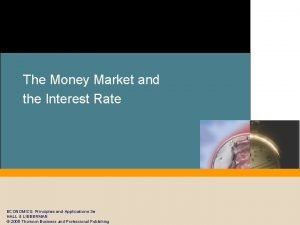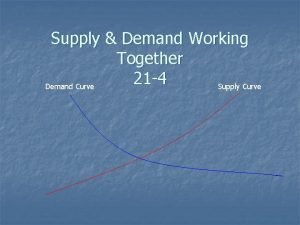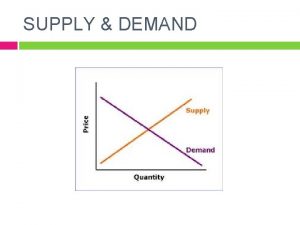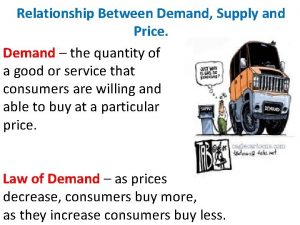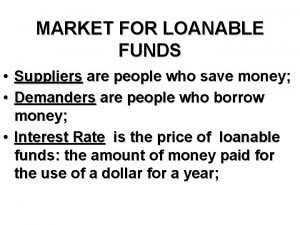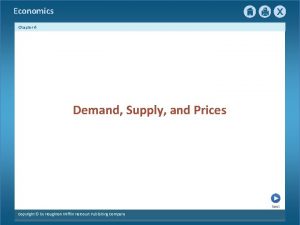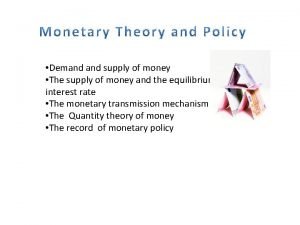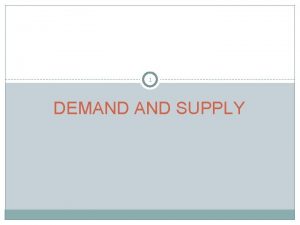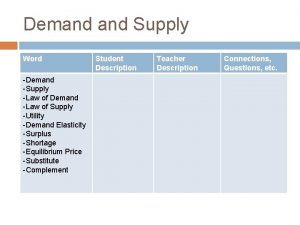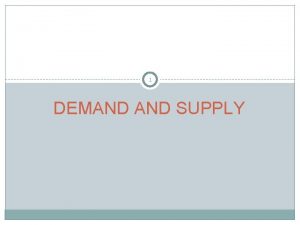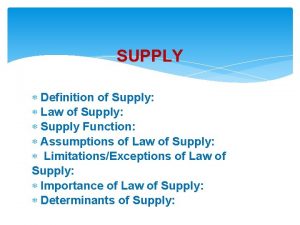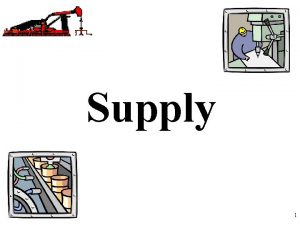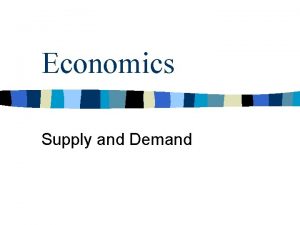SUPPLY AND DEMAND Demand The demand for a

















- Slides: 17

SUPPLY AND DEMAND

Demand • The demand for a product is made up of the desire for customers to have the product and their willingness and ability to pay for it. • The demand for a good or service can be illustrated using a demand curve:

Demand Curve For most products the demand curve slopes downwards from left to right, indicating that the level of demand increases as price falls.

Factors that Influence Demand • Affordability: determined by the price of a product/service and the income of the customers wishing to purchase it. As the price falls more people can afford it and so demand is likely to rise; falling prices also mean that customers have to sacrifice less in order to obtain the product in question.

Factors that Influence Demand • Competition and availability of substitutes: a substitute good or service is one that performs a similar or identical function to that of another product. Competition is most fierce in markets where there is little, if any, differentiation between products. Firms that sell products that can be easily substituted are particularly vulnerable to changes in price.

Factors that Influence Demand • Level of Gross Domestic Product (GDP): GDP is an estimate of the value of the output produced nationally over a given period of time. GDP increases when economic growth takes place during a period of recovery or boom but falls during a recession or slump. An increase in GDP implies an increase in demand generally for the goods and services produced by an economy.

Factors that Influence Demand • Consumer needs and aspirations: these are at the heart of the willingness of consumers to want to buy goods and services. However consumer needs, tastes and aspirations change over time. The demand for some products increases as needs grow or are created while the demand for products that are no longer needed falls and eventually disappears completely.

Factors that Influence Demand • EG the invention of new products such as HD television and MP 3 players creates needs that did not exist previously. Changes in fashion are also significant in markets such as clothing and children’s toys. Demand rises quickly for the latest ‘must have’ item but can disappear just as quickly as goods go out of fashion.

Factors that Influence Demand • Additional factors: – Promotional campaigns – can boost the awareness and therefore the demand for a product/service although this may be temporary. – Change in the size/structure of the population eg a rise in the number of children being born would increase the demand for baby products and in the longer term put pressure on services such as nursery care and education.

Changes in Influence • A change in any of the influences on demand other than a change in price results in a shift in the demand curve. EG a significant rise in average incomes or beneficial exchange rates is likely to cause demand foreign holidays to increase. Even though there has been no change in price, consumers have more money to spend. A fall in average incomes will have the opposite effect.

SUPPLY • This is concerned with the ability and willingness of firms to produce and sell the goods and services demanded by customers. • The supply of a product can be illustrated using a supply curve.

Supply The supply of a product can be illustrated using a supply curve. For most products, the supply curve slopes upwards from left to right, indicating that the level of supply increases at the price level increases

Factors that influence supply • Availability of raw materials and labour: all firms need materials and workers with appropriate skills in order to deliver the goods or services they set out to produce. The cost and availability of these resources have a direct impact on output levels. If the cost of these rises, then supply could fall, as the increased costs of production can potentially reduce the level of profits made.

Factors that influence supply • Logistics: this refers to the distribution of goods (and other resources) between where they are produced and where they are likely to be consumed. Logistics involve a number of activities including transportation and warehousing. The level of supply is likely to depend on how easily firms can get hold of the right quantity of materials to satisfy production.

Factors that influence supply • Logistics contd. • Many manufacturers operate just-in-time production systems that require flexibility from suppliers and rely heavily on the ability to receive orders at very short notice. Supply also depends on the speed and ease with which finished goods and services can be made available to customers.

Factors that influence supply • The influence of profit: profit is a key objective of most businesses in the private sector. The profit made on each item sold is simply the difference between the sales price and the cost of producing it. When the price of a product is very low only the most efficient firms will be able to operate with low enough costs to make a profit.

Factors that influence supply • Government support: there a number of ways in which government support is given to businesses including grants, subsidies and lowrate or interest-free loans. EG the New Deal, introduced in 1998 by the Labour government, paid subsidies to employers who hire long-term unemployed workers and also contributes to the cost of training them. This type of government support reduces firms’ operating costs and the opportunity to make higher levels of profit leads to an increase in supply.
 Matching supply and demand in supply chain
Matching supply and demand in supply chain Module 5 supply and demand introduction and demand
Module 5 supply and demand introduction and demand Chapter 5 section 1 supply and the law of supply
Chapter 5 section 1 supply and the law of supply Ang elastisidad ng supply ay
Ang elastisidad ng supply ay Unit 2 demand supply and consumer choice
Unit 2 demand supply and consumer choice 5 determinants of supply
5 determinants of supply Unit 2 demand supply and consumer choice
Unit 2 demand supply and consumer choice Money market equilibrium
Money market equilibrium Combining supply and demand worksheet
Combining supply and demand worksheet Interaction of demand and supply
Interaction of demand and supply Combining supply and demand worksheet
Combining supply and demand worksheet Supply and demand of loanable funds
Supply and demand of loanable funds Shifters of supply for loanable funds
Shifters of supply for loanable funds Supply and demand economics project
Supply and demand economics project Chapter 6 section 1 price supply and demand together
Chapter 6 section 1 price supply and demand together Money supply curve
Money supply curve Rule of supply and demand
Rule of supply and demand Shift in sras curve
Shift in sras curve







